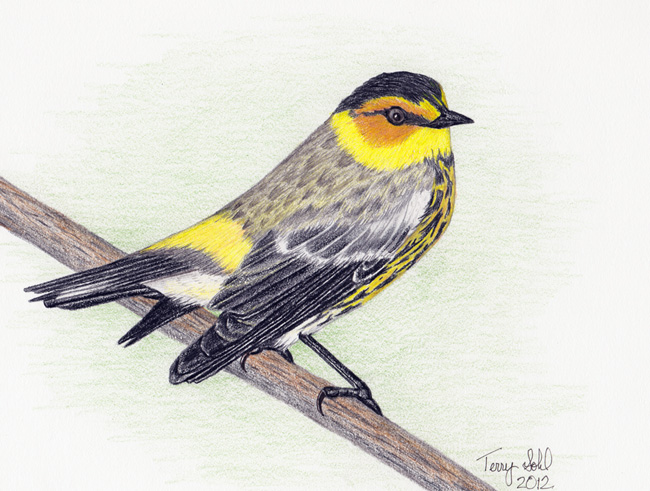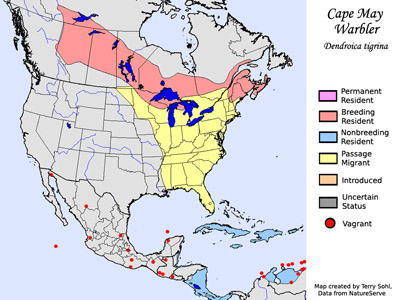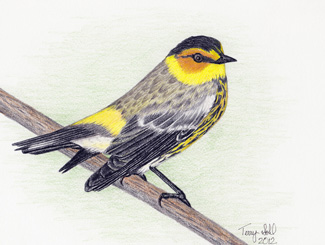| Length: 4.75 inches | Wingspan: 7 inches | Seasonality: Migrant |
| ID Keys: Male has crisp black stripes on yellow underparts, a chestnut ear patch, yellow on face and neck, and a large white wing patch. Females similar but duller. | ||
 The Cape May Warbler leads very different lives during the
summer and winter months. During the summer, they are most often found in
spruce forests, where they have access to their favorite summer food item,
spruce budworms. They spend their winter on Caribbean islands and in
southern Florida, where much of their diet may shift to nectar, sap, and juices
obtained from puncturing fruit. The Cape May Warbler is the only warbler
with a tubular tongue adapted to feeding on nectar from flowers.
The Cape May Warbler leads very different lives during the
summer and winter months. During the summer, they are most often found in
spruce forests, where they have access to their favorite summer food item,
spruce budworms. They spend their winter on Caribbean islands and in
southern Florida, where much of their diet may shift to nectar, sap, and juices
obtained from puncturing fruit. The Cape May Warbler is the only warbler
with a tubular tongue adapted to feeding on nectar from flowers.
Habitat: During the summer breeding season, they are found in spruce forest, usually in open forests or near woodland edges. During migration, they also prefer conifers but can be found in deciduous trees and brushy thickets as well. They are often found in palm trees during their winter months in the Caribbean and Florida.
Diet: In the summer, they primarily feeds on insects, and are especially fond of spruce budworms. During migration and in winter, they often feed on nectar, and juice obtained by piercing fruits. They will also drink sap from sapsucker drill holes.
Behavior: On summer on its preferred spruce forest habitat, usually feeds at the end of spruce branches in search of insects. They will also occasionally fly out from a perch to capture insects in mid-air.
Breeding: Non-breeder in South Dakota
Song: A high-pitched see-see-see-see.
Migration: Summers throughout central and southeastern Canada, the Great Lakes region, and northern New England. Winters in the Caribbean and southern Florida.
Interactive eBird Map: Click to access an interactive eBird map of Cape May Warbler sightings
Similar Species: Yellow-rumped Warbler, Palm Warbler
Conservation Status: Possibly has become more common in recent decades. Populations seem to boom and bust with populations of spruce budworms, a favorite food item.
Further Information: 1) USGS Patuxent Bird Identification InfoCenter, Cape May Warbler
3) Audubon Guide - Cape May Warbler
Image Information: Colored pencil drawing by Terry Sohl - 2012
| Click on the map below for a higher-resolution view |
 |
| South Dakota Status: Rare migrant in the eastern part of the state, accidental in the west. |
Additional Cape May Warbler Images

